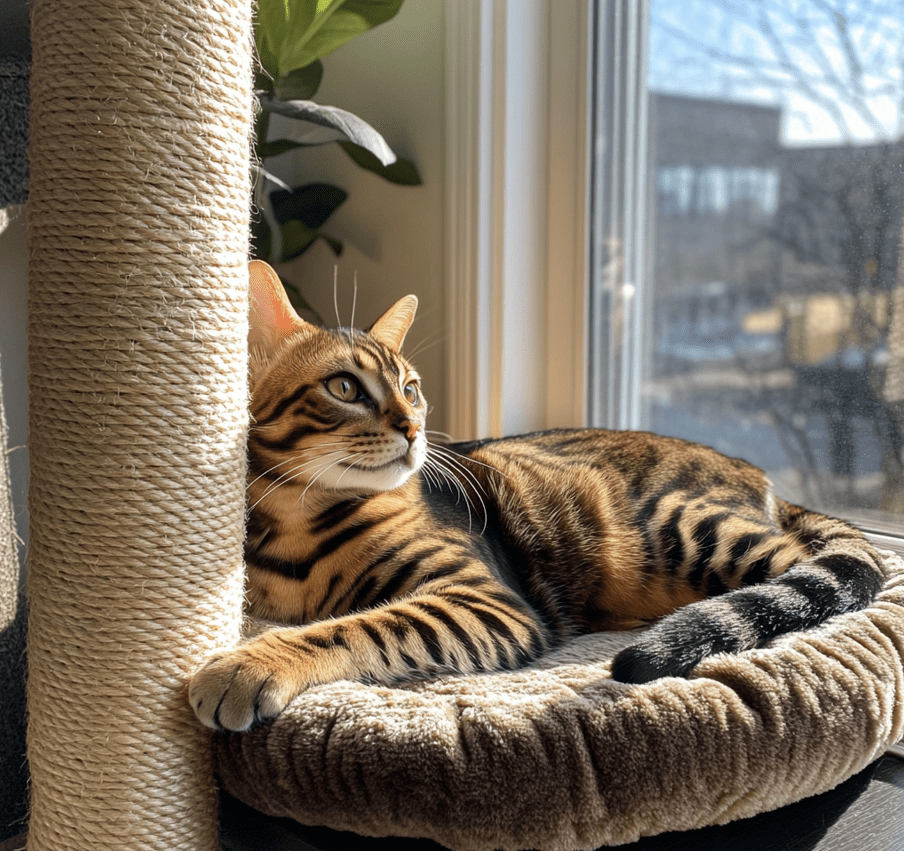
If your Bengal cat is urinating outside the litter box, you’re likely feeling frustrated and concerned. This behavior, while common, can stem from various causes, ranging from medical issues to environmental stressors. Bengal cats, known for their high energy and intelligence, may exhibit this behavior due to specific needs not being met. In this comprehensive guide, we’ll explore why your Bengal cat is urinating outside the litter box, offer practical fixes that work, and provide insights to restore harmony in your home.
Understanding the Problem: Why Bengals Urinate Outside the Litter Box
Bengal cats are unique, with their wild-like appearance and active personalities. However, their tendency to urinate outside the litter box can signal underlying issues. This behavior, often referred to as inappropriate elimination, is one of the top reasons cats are surrendered to shelters. By identifying the root cause, you can address the issue effectively.
Common Reasons for Inappropriate Urination
Medical Issues
Health problems are a leading cause of litter box avoidance. Urinary tract infections (UTIs), bladder stones, kidney disease, or diabetes can cause discomfort, prompting your Bengal to associate the litter box with pain.
Symptoms to Watch For: Straining, frequent urination, blood in urine, or excessive grooming around the genital area.
Fix: Schedule a vet visit immediately. A urinalysis or imaging may be needed to diagnose the issue. Early treatment can prevent escalation.
Litter Box Issues
Bengals are fastidious and may reject a litter box that doesn’t meet their standards.
Dirty Litter Box: Bengals prefer clean environments. A soiled box can deter them.
Litter Type: Some Bengals dislike certain litter textures, such as clay or scented varieties.
Box Size or Location: A box that’s too small or placed in a high-traffic area may feel uninviting.
Fix: Clean the box daily, experiment with unscented, clumping litter, and ensure the box is large enough (1.5 times the cat’s length). Place it in a quiet, accessible spot.
Stress and Anxiety
Bengals are sensitive to environmental changes. Stressors like new pets, moving, or loud noises can trigger inappropriate urination.
Fix: Identify and minimize stressors. Provide safe spaces, such as cat trees or hiding spots, and use pheromone diffusers like Feliway to calm your cat.
Territorial Marking
Unneutered or unspayed Bengals may spray to mark territory, especially in multi-cat households.
Fix: Spay or neuter your cat if not already done. This reduces hormonal-driven marking. For multi-cat homes, ensure each cat has their own resources (litter boxes, food bowls, etc.).
Behavioral Issues
Bengals are highly intelligent and require mental and physical stimulation. Boredom or frustration can lead to litter box avoidance.
Fix: Enrich their environment with interactive toys, puzzle feeders, and regular playtime. Bengals thrive on activities mimicking hunting.
Step-by-Step Solutions to Stop Your Bengal Cat from Urinating Outside the Litter Box
Addressing this issue requires a systematic approach. Follow these steps to pinpoint the cause and implement effective solutions.

Step 1: Rule Out Medical Problems
Action: Visit your veterinarian for a thorough exam. Tests may include blood work, urinalysis, or X-rays to check for infections, crystals, or other conditions.
Why It Works: Treating medical issues resolves the root cause of discomfort, encouraging litter box use.
Pro Tip: Monitor your cat’s water intake and urination patterns to provide your vet with detailed information.
Step 2: Optimize the Litter Box Setup
Cleanliness: Scoop the litter box at least once daily and replace litter weekly. Wash the box with mild soap monthly.
Litter Choice: Test different litters, such as clumping, unscented clay, or natural options like pine or corn. Bengals often prefer fine, sand-like textures.
Box Size and Number: Use a large, uncovered box. The rule of thumb is one box per cat plus one extra. For example, a single Bengal needs two boxes.
Location: Place boxes in low-traffic, private areas, away from food and water bowls.
Why It Works: A clean, comfortable, and accessible litter box meets your Bengal’s instincts for hygiene and safety.
Step 3: Reduce Stress and Enrich the Environment
Create Safe Spaces: Install cat trees, shelves, or cozy beds where your Bengal can retreat.
Pheromone Therapy: Use Feliway diffusers or sprays to create a calming environment.
Routine: Maintain a consistent feeding and play schedule to provide stability.
Enrichment: Offer toys like feather wands, laser pointers, or puzzle feeders. Bengals love activities that engage their hunting instincts.
Why It Works: Reducing stress and boredom prevents behavioral issues, encouraging proper litter box use.
Step 4: Address Territorial Behavior
Spay/Neuter: If your Bengal isn’t fixed, consult your vet about spaying or neutering to reduce marking.
Multi-Cat Households: Ensure each cat has their own territory, including separate litter boxes and feeding areas.
Clean Marked Areas: Use enzymatic cleaners to remove urine odors, as Bengals may return to marked spots.
Why It Works: Eliminating territorial triggers discourages spraying and promotes litter box use.
Step 5: Monitor and Adjust
Track Progress: Keep a journal of your cat’s behavior, noting when and where they urinate outside the box.
Experiment: If one fix doesn’t work, try another. For example, if changing litter doesn’t help, focus on stress reduction.
Consult a Behaviorist: For persistent issues, a feline behaviorist can provide tailored advice.
Why It Works: Ongoing observation ensures you address the specific cause, leading to long-term success.
Additional Tips for Bengal Cat Owners
Bengals have unique needs due to their high energy and intelligence. Here are extra tips to prevent litter box issues:
Exercise: Bengals need at least 30–60 minutes of active play daily. Use toys that mimic prey to satisfy their hunting instincts.
Water Intake: Encourage hydration with a cat fountain, as Bengals are drawn to running water. This supports urinary health.
Training: Bengals are trainable. Use positive reinforcement to reward litter box use.
Bonding: Spend quality time with your Bengal to build trust, reducing stress-related behaviors.
Regular Vet Checkups: Annual exams catch health issues early, preventing litter box avoidance.
Common Mistakes to Avoid

Punishing Your Cat: Yelling or scolding can increase stress, worsening the problem.
Using Scented Litter: Strong smells may repel Bengals, who prefer neutral environments.
Ignoring Medical Issues: Delaying a vet visit can lead to chronic conditions.
Inconsistent Cleaning: A dirty litter box is a major deterrent for fastidious Bengals.
Overlooking Stress: Changes in your home, like new furniture or visitors, can affect your cat’s behavior.
When to Seek Professional Help
If you’ve tried the above solutions and your Bengal still urinates outside the litter box, it’s time to seek expert advice.
Veterinarian: Persistent issues may indicate complex medical conditions, such as interstitial cystitis.
Feline Behaviorist: A professional can assess your home environment and cat’s behavior, offering customized strategies.
Cat Trainer: For Bengals, training programs can reinforce positive litter box habits.
Preventive Measures for Long-Term Success
Preventing future litter box issues is key to a happy relationship with your Bengal.
Maintain a Clean Environment: Regular litter box maintenance is non-negotiable.
Monitor Health: Watch for changes in urination, appetite, or behavior, and address them promptly.
Provide Enrichment: Keep your Bengal mentally and physically stimulated to avoid boredom.
Stay Consistent: Stick to routines and avoid sudden changes in your cat’s environment.
Build Trust: A strong bond with your Bengal reduces stress and behavioral issues.
Understanding Your Bengal’s Unique Needs
Bengals are a hybrid breed, descended from the Asian leopard cat, which explains their wild instincts and high energy. Unlike other domestic cats, Bengals require more attention to their environment, diet, and activity levels. Their intelligence makes them prone to boredom, which can manifest as litter box avoidance. By catering to their specific needs, you can prevent and resolve inappropriate urination.
Key Bengal Traits That Influence Behavior
High Energy: Bengals need outlets for their energy, or they may act out.
Curiosity: They explore and may reject litter boxes that feel unsafe or unappealing.
Sensitivity: Bengals pick up on subtle changes, so stress management is crucial.
Hygiene: Their fastidious nature means they demand clean, comfortable litter boxes.
Conclusion

Dealing with a Bengal cat urinating outside the litter box can be challenging, but with patience and a systematic approach, you can resolve the issue. Start by ruling out medical problems, optimize the litter box setup, and address stress or behavioral triggers. By understanding your Bengal’s unique needs and providing a stimulating, stable environment, you’ll encourage proper litter box use and strengthen your bond. Implement the fixes outlined in this guide, and you’ll be on your way to a happier, healthier relationship with your Bengal cat.


